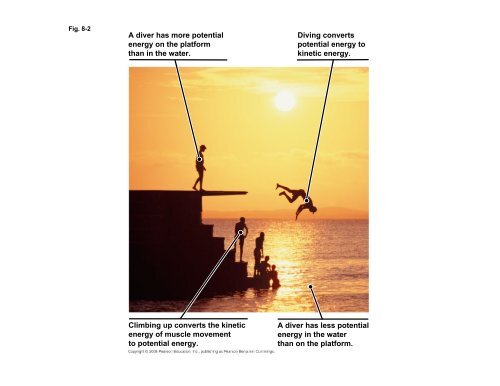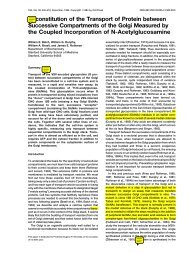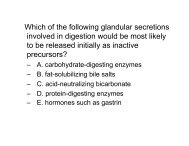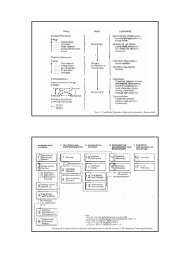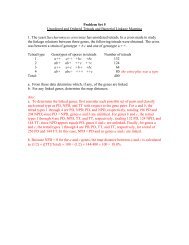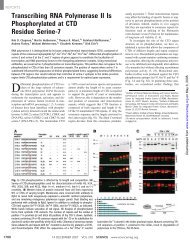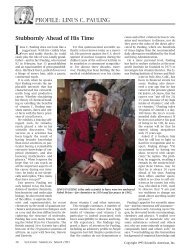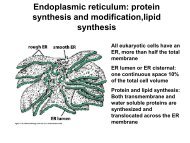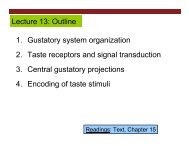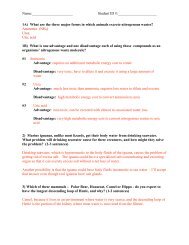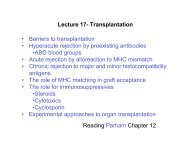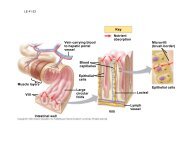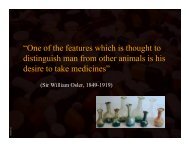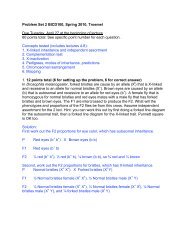Climbing up converts the kinetic energy of muscle movement to ...
Climbing up converts the kinetic energy of muscle movement to ...
Climbing up converts the kinetic energy of muscle movement to ...
Create successful ePaper yourself
Turn your PDF publications into a flip-book with our unique Google optimized e-Paper software.
Fig. 8-2<br />
A diver has more potential<br />
<strong>energy</strong> on <strong>the</strong> platform<br />
than in <strong>the</strong> water.<br />
<strong>Climbing</strong> <strong>up</strong> <strong>converts</strong> <strong>the</strong> <strong>kinetic</strong><br />
<strong>energy</strong> <strong>of</strong> <strong>muscle</strong> <strong>movement</strong><br />
<strong>to</strong> potential <strong>energy</strong>.<br />
Diving <strong>converts</strong><br />
potential <strong>energy</strong> <strong>to</strong><br />
<strong>kinetic</strong> <strong>energy</strong>.<br />
A diver has less potential<br />
<strong>energy</strong> in <strong>the</strong> water<br />
than on <strong>the</strong> platform.
Fig. 8-5a<br />
• More free <strong>energy</strong> (higher G)<br />
• Less stable<br />
• Greater work capacity<br />
In a spontaneous change<br />
• The free <strong>energy</strong> <strong>of</strong> <strong>the</strong> system<br />
decreases (∆G < 0)<br />
• The system becomes more<br />
stable<br />
• The released free <strong>energy</strong> can<br />
be harnessed <strong>to</strong> do work<br />
• Less free <strong>energy</strong> (lower G)<br />
• More stable<br />
• Less work capacity
Fig. 8-5b<br />
Spontaneous<br />
change<br />
(a) Gravitational motion<br />
Spontaneous<br />
change<br />
Spontaneous<br />
change<br />
(b) Diffusion (c) Chemical reaction
Free <strong>energy</strong><br />
Fig. 8-6a<br />
Reactants<br />
Energy<br />
Progress <strong>of</strong> <strong>the</strong> reaction<br />
(a) Exergonic reaction: <strong>energy</strong> released<br />
Products<br />
Amount <strong>of</strong><br />
<strong>energy</strong><br />
released<br />
(∆G < 0)
Free <strong>energy</strong><br />
Fig. 8-6b<br />
Reactants<br />
Energy<br />
Progress <strong>of</strong> <strong>the</strong> reaction<br />
Products<br />
(b) Endergonic reaction: <strong>energy</strong> required<br />
Amount <strong>of</strong><br />
<strong>energy</strong><br />
required<br />
(∆G > 0)
Fig. 8-7a<br />
∆G < 0 ∆G = 0<br />
(a) An isolated hydroelectric system
Fig. 8-7b<br />
∆G < 0<br />
(b) An open hydroelectric system
Fig. 8-7c<br />
∆G < 0<br />
∆G < 0<br />
(c) A multistep open hydroelectric system<br />
∆G < 0
Fig. 8-8<br />
Phosphate gro<strong>up</strong>s<br />
Adenine<br />
Ribose
Fig. 8-9<br />
Inorganic phosphate<br />
P P P<br />
Adenosine triphosphate (ATP)<br />
P + P P<br />
+<br />
i<br />
H 2 O<br />
Adenosine diphosphate (ADP)<br />
Energy
Fig. 8-10<br />
1<br />
2<br />
Glu<br />
Glutamic<br />
acid<br />
ATP phosphorylates<br />
glutamic acid,<br />
making <strong>the</strong> amino<br />
acid less stable.<br />
Ammonia displaces<br />
<strong>the</strong> phosphate gro<strong>up</strong>,<br />
forming glutamine.<br />
+<br />
(a) Endergonic reaction<br />
Glu<br />
Glu<br />
NH 3<br />
Ammonia<br />
P<br />
ATP<br />
NH 3<br />
(b) Co<strong>up</strong>led with ATP hydrolysis, an exergonic reaction<br />
(c) Overall free-<strong>energy</strong> change<br />
+<br />
+<br />
NH 2<br />
Glu<br />
Glutamine<br />
∆G = +3.4 kcal/mol<br />
Glu<br />
NH 2<br />
Glu<br />
P<br />
+<br />
P<br />
+ ADP<br />
i
Fig. 8-11<br />
ATP<br />
Membrane protein<br />
P<br />
Solute Solute transported<br />
(a) Transport work: ATP phosphorylates<br />
transport proteins<br />
Vesicle Cy<strong>to</strong>skeletal track<br />
ATP<br />
Mo<strong>to</strong>r protein Protein moved<br />
(b) Mechanical work: ATP binds noncovalently<br />
<strong>to</strong> mo<strong>to</strong>r proteins, <strong>the</strong>n is hydrolyzed<br />
P i<br />
ADP<br />
+<br />
P i
Fig. 8-12<br />
Energy from<br />
catabolism (exergonic,<br />
<strong>energy</strong>-releasing<br />
processes)<br />
ATP + H 2 O<br />
ADP +<br />
P i<br />
Energy for cellular<br />
work (endergonic,<br />
<strong>energy</strong>-consuming<br />
processes)
Fig. 8-13<br />
Sucrose (C 12H 22O 11)<br />
Sucrase<br />
Glucose (C 6H 12O 6) Fruc<strong>to</strong>se (C 6H 12O 6)
Fig. 8-14<br />
Free <strong>energy</strong><br />
A<br />
C<br />
B<br />
D<br />
Reactants<br />
A<br />
C<br />
B<br />
Transition state<br />
E A<br />
D<br />
Progress <strong>of</strong> <strong>the</strong> reaction<br />
A<br />
C<br />
B<br />
D<br />
Products<br />
∆G < O
Free <strong>energy</strong><br />
Fig. 8-15<br />
Course <strong>of</strong><br />
reaction<br />
without<br />
enzyme<br />
Reactants<br />
Course <strong>of</strong><br />
reaction<br />
with enzyme<br />
E A<br />
without<br />
enzyme<br />
Progress <strong>of</strong> <strong>the</strong> reaction<br />
Products<br />
E A with<br />
enzyme<br />
is lower<br />
∆G is unaffected<br />
by enzyme
Fig. 8-16<br />
Substrate<br />
Active site<br />
(a)<br />
Enzyme Enzyme-substrate<br />
complex<br />
(b)
Fig. 8-17<br />
1 Substrates enter active site; enzyme<br />
changes shape such that its active site<br />
enfolds <strong>the</strong> substrates (induced fit).<br />
Substrates<br />
6 Active<br />
site is<br />
available<br />
for two new<br />
substrate<br />
molecules.<br />
Enzyme<br />
5<br />
Products are<br />
released.<br />
Products<br />
Enzyme-substrate<br />
complex<br />
2 Substrates held in<br />
active site by weak<br />
interactions, such as<br />
hydrogen bonds and<br />
ionic bonds.<br />
4<br />
Substrates are<br />
converted <strong>to</strong><br />
products.<br />
3 Active site can lower EA and speed <strong>up</strong> a reaction.
Fig. 8-18<br />
Rate <strong>of</strong> reaction<br />
Rate <strong>of</strong> reaction<br />
Optimal temperature for<br />
typical human enzyme<br />
Optimal temperature for<br />
enzyme <strong>of</strong> <strong>the</strong>rmophilic<br />
(heat-<strong>to</strong>lerant)<br />
bacteria<br />
0 20 40 60 80 100<br />
Temperature (ºC)<br />
(a) Optimal temperature for two enzymes<br />
Optimal pH for pepsin<br />
(s<strong>to</strong>mach enzyme)<br />
Optimal pH<br />
for trypsin<br />
(intestinal<br />
enzyme)<br />
0 1 2 3 4<br />
pH<br />
5 6 7 8 9 10<br />
(b) Optimal pH for two enzymes
Fig. 8-19<br />
Substrate<br />
Active site<br />
Enzyme<br />
Competitive<br />
inhibi<strong>to</strong>r<br />
Noncompetitive inhibi<strong>to</strong>r<br />
(a) Normal binding (b) Competitive inhibition (c) Noncompetitive inhibition
Fig. 8-20a<br />
Allosteric enzyme<br />
with four subunits<br />
Regula<strong>to</strong>ry<br />
site (one<br />
<strong>of</strong> four)<br />
Nonfunctional<br />
active<br />
site<br />
Oscillation<br />
Inactive form<br />
Active site<br />
(one <strong>of</strong> four)<br />
Activa<strong>to</strong>r<br />
Active form Stabilized active form<br />
Inhibi<strong>to</strong>r<br />
(a) Allosteric activa<strong>to</strong>rs and inhibi<strong>to</strong>rs<br />
Stabilized inactive<br />
form
Fig. 8-20b<br />
Inactive form<br />
Substrate<br />
Stabilized active<br />
form<br />
(b) Cooperativity: ano<strong>the</strong>r type <strong>of</strong> allosteric activation
Fig. 8-22<br />
Isoleucine<br />
used <strong>up</strong> by<br />
cell<br />
Isoleucine<br />
binds <strong>to</strong><br />
allosteric<br />
site<br />
Feedback<br />
inhibition<br />
Active site<br />
available<br />
Active site <strong>of</strong><br />
enzyme 1 no<br />
longer binds<br />
threonine;<br />
pathway is<br />
switched <strong>of</strong>f.<br />
Intermediate A<br />
Enzyme 2<br />
Intermediate B<br />
Enzyme 3<br />
Intermediate C<br />
Enzyme 4<br />
Intermediate D<br />
Enzyme 5<br />
Initial substrate<br />
(threonine)<br />
Threonine<br />
in active site<br />
Enzyme 1<br />
(threonine<br />
deaminase)<br />
End product<br />
(isoleucine)
Fig. 8-23<br />
Mi<strong>to</strong>chondria<br />
1 µm


